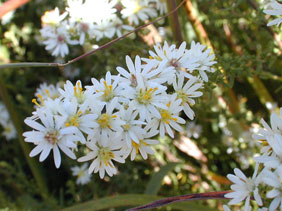HEATH ASTER
|
 |
| File Size: 79 KB |
|
|
|
Symphyotrichum ericoides (L. ) G.L. Nesom
|
| [=Aster ericoides L.] |
| Konza Prairie, Riley County, Kansas |
| Perennial |
| Height: 1-3 feet |
| Family: Asteraceae - Sunflower Family |
| Flowering Period: September,October |
|
| Also Called: | | White aster, many-flowered aster. | | Stems: | | Ascending or erect to almost prostrate, few to many, often clustered, slender, stiff, much-branched, rough hairy above. | | Leaves: | | Alternate, simple, sessile or slightly clasping, linear to linear-lanceolate, 1/2 to 2 inches long, less than 1/4 inch wide, rigid, rough; margins entire; tips pointed; branch leaves much smaller and crowded; most basal and lower stem leaves absent at flowering. | | Inflorescences: | | Panicles of numerous, densely crowded heads, primarily on 1 side of arching branches. | | Flowers: | | Heads cylindric to bell-shaped, less than 1/2 inch across; bracts strongly overlapping, tipped with bristles; ray florets 10-18, white or rarely pinkish; disk florets 5-14, corollas yellowish to reddish purple. | | Fruits: | | Achenes, small, appressed-hairy, purplish brown, tipped with white, hair-like bristles, enclosing small, silky seed. | | Habitat: | | Dry open prairies, disturbed sites, pastures, and roadsides. | | Distribution: | | Throughout Kansas. | | Toxicity: | | Known to accumulate selenium, but livestock rarely consume it. | | Comments: | | This is the most common Kansas aster. It grows in colonies and is drought hardy, with roots that descend 3 to 8 feet. Heath aster is one of the last plants to remain in flower in the autumn. Heath aster lowers the quality of prairie hay. |
|
| Heath aster |  | | 149 KB | | Chase County, Kansas |
| | Heath aster |  | | 79 KB | | Konza Prairie, Riley County, Kansas |
| | Heath aster |  | | 171 KB | | Konza Prairie, Riley County, Kansas |
| | Heath aster |  | | 113 KB | | McPherson County, Kansas |
| | Heath aster habit |  | | 241 KB | | Atchison County, Kansas |
| | Heath aster inflorescence |  | | 119 KB | | Tallgrass Prairie National Preserve, Chase County, Kansas |
| | | | |
|
|
|
|
|
|